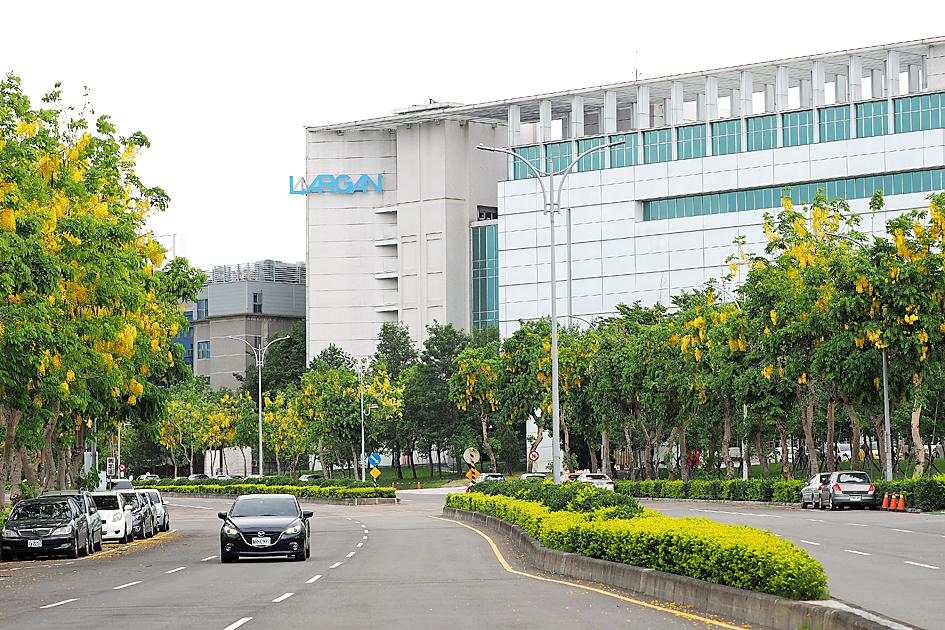Largan Precision Co (大立光), a major camera lens supplier to Apple Inc’s iPhones, yesterday said that it expects revenue to dip further next month, dampened by semiconductor supply constraints and fewer working days due to the Lunar New Year holiday.
As order visibility remains low, Largan cannot provide a clear business outlook for March and this quarter, Largan chief executive Adam Lin (林恩平) told an investors’ teleconference.
“It appears that January [revenue] will be weaker than December. February will be even lower due to the Lunar New Year holiday,” Lin said.

Photo: David Chang, EPA-EFE
It is still premature to predict when revenue would return to monthly growth, he said.
“The scarcity of semiconductors remains severe and that spells some problems,” Lin said. “We do not have a clear picture for March.”
Largan attributed the shortage of some semiconductors to lower revenue last month, missing the company’s estimate of no change from November last year.
However, customers remain active in designing new camera lenses for premium smartphones this quarter, the Taichung-based firm said.
It has received as many projects this quarter as in the same period last year, Lin said.
It is uncertain whether those projects would ultimately contribute to revenue, he said.
In the third quarter last year, one of Largan’s customers scrapped its orders for high-end, high-margin camera lenses, dealing a blow to its gross margin last quarter.
Huawei Technologies Co (華為) was widely believed to be the customer after the US imposed a ban on some exports to the Chinese company.
The order loss drove gross margin down to 64.43 percent from 65.65 percent in the previous quarter, the weakest in seven quarters.
Gross margin for all of last year dipped to 66.98 percent, the firm’s lowest since 2015.
Twenty-megapixel lenses accounted for 10 to 20 percent of its overall shipments last quarter, down from 20 to 30 percent in the third quarter last year, the company said.
To fill the capacity void, Largan does not rule out the possibility of producing mid-range lenses for customers at good prices, Lin said.
The company would supply voice coil motors (VCM) on request, as it has been making them for the past five or six years, he said.
The company is reportedly to start supplying VCMs for new iPhones this year.
Net profit tumbled 19.41 percent to NT$6.52 billion (US$229.34 million) last quarter, compared with NT$8.09 billion in the same quarter of 2019, but rose 18.4 percent from NT$5.87 billion in the third quarter last year.
Earnings per share (EPS) dipped to NT$51.83 last quarter from NT$60.32 a year earlier, an increase from NT$43.74 in the prior quarter.
Largan’s net profit last year was NT$24.53 billion, contracting 13 percent from NT$28.26 billion in 2018. EPS fell to NT$182.86 from NT$210.7.
Separately, Largan said that a new plant would become operational in 2023 as scheduled.

CHIP RACE: Three years of overbroad export controls drove foreign competitors to pursue their own AI chips, and ‘cost US taxpayers billions of dollars,’ Nvidia said China has figured out the US strategy for allowing it to buy Nvidia Corp’s H200s and is rejecting the artificial intelligence (AI) chip in favor of domestically developed semiconductors, White House AI adviser David Sacks said, citing news reports. US President Donald Trump on Monday said that he would allow shipments of Nvidia’s H200 chips to China, part of an administration effort backed by Sacks to challenge Chinese tech champions such as Huawei Technologies Co (華為) by bringing US competition to their home market. On Friday, Sacks signaled that he was uncertain about whether that approach would work. “They’re rejecting our chips,” Sacks

Taiwan’s long-term economic competitiveness will hinge not only on national champions like Taiwan Semiconductor Manufacturing Co. (TSMC, 台積電) but also on the widespread adoption of artificial intelligence (AI) and other emerging technologies, a US-based scholar has said. At a lecture in Taipei on Tuesday, Jeffrey Ding, assistant professor of political science at the George Washington University and author of "Technology and the Rise of Great Powers," argued that historical experience shows that general-purpose technologies (GPTs) — such as electricity, computers and now AI — shape long-term economic advantages through their diffusion across the broader economy. "What really matters is not who pioneers

BUBBLE? Only a handful of companies are seeing rapid revenue growth and higher valuations, and it is not enough to call the AI trend a transformation, an analyst said Artificial intelligence (AI) is entering a more challenging phase next year as companies move beyond experimentation and begin demanding clear financial returns from a technology that has delivered big gains to only a small group of early adopters, PricewaterhouseCoopers (PwC) Taiwan said yesterday. Most organizations have been able to justify AI investments through cost recovery or modest efficiency gains, but few have achieved meaningful revenue growth or long-term competitive advantage, the consultancy said in its 2026 AI Business Predictions report. This growing performance gap is forcing executives to reconsider how AI is deployed across their organizations, it said. “Many companies

TAIWAN VALUE CHAIN: Foxtron is to fully own Luxgen following the transaction and it plans to launch a new electric model, the Foxtron Bria, in Taiwan next year Yulon Motor Co (裕隆汽車) yesterday said that its board of directors approved the disposal of its electric vehicle (EV) unit, Luxgen Motor Co (納智捷汽車), to Foxtron Vehicle Technologies Co (鴻華先進) for NT$787.6 million (US$24.98 million). Foxtron, a half-half joint venture between Yulon affiliate Hua-Chuang Automobile Information Technical Center Co (華創車電) and Hon Hai Precision Industry Co (鴻海精密), expects to wrap up the deal in the first quarter of next year. Foxtron would fully own Luxgen following the transaction, including five car distributing companies, outlets and all employees. The deal is subject to the approval of the Fair Trade Commission, Foxtron said. “Foxtron will be